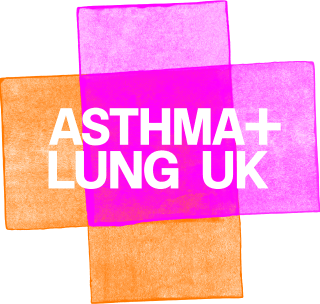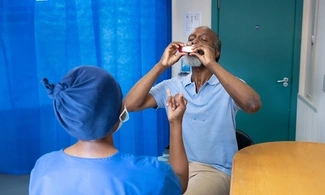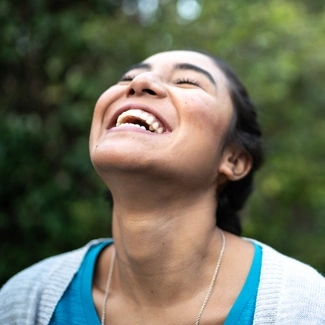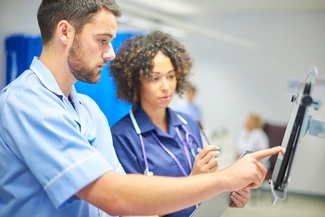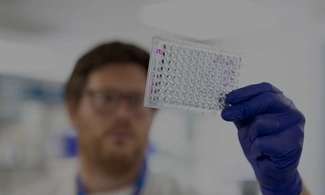- What is COVID-19?
- Am I more at risk because of my lung condition?
- Am I eligible for COVID-19 vaccine boosters?
- Is the COVID-19 vaccine safe if I have a lung condition?
- What do I do if I get COVID-19?
- Am I eligible for anti-viral treatments?
- Recovering from COVID-19
- What can I do to avoid COVID-19?
- Looking after your wellbeing
What is COVID-19?
COVID-19 is a respiratory virus. The symptoms can be similar to colds and flu.
Some symptoms of COVID-19 may also be similar to ones you get with your lung condition, like feeling short of breath, coughing, or feeling very tired.
COVID-19 can spread easily between people. You may catch it if someone with the virus is talking to you, or coughs and sneezes near you.
Am I more at risk because of my lung condition?
If you have a lung condition, or if you’ve had a lung transplant, you may be more at risk of becoming very ill with COVID-19. But not everyone with a lung condition will become very ill with COVID-19.
Most people now have good protection against COVID-19 thanks to vaccines and recovery from previous infection with COVID-19. That includes most people with lung conditions including asthma, COPD, and bronchiectasis.
Research shows that for most people the risk of becoming seriously ill from COVID-19 is now much lower than it was when the pandemic started.
Am I eligible for COVID-19 vaccine boosters?
COVID-19 vaccines and boosters have worked well since the pandemic started. They’ve stopped people getting seriously ill from COVID-19 and kept people out of hospital.
Most people no longer need extra doses of the vaccine, so the NHS is now offering booster vaccines to people who will benefit most from them.
This includes:
- adults aged 75 years and over
- residents in care homes for older adults
- individuals who are immunosuppressed aged 6 months and over.
If you belong to one of these groups, you should get a text, email or letter inviting you for your COVID-19 vaccine twice a year, once in spring, and once in early winter.
Ask your GP surgery if you have not been invited, and think you should have been.
The NHS has more information about who is eligible for a COVID-19 vaccine, how to book, and where to find walk-in services.
What does immunosuppressed mean?
If you’re immunosuppressed it means your immune system (the system in your body which helps you fight infection) does not work well.
You may be immunosuppressed because you have a health condition, or take treatments that suppress your immune system.
If you have a lung condition you may be immunosuppressed if:
- you’re being treated for lung cancer
- you’ve had a lung transplant
- you take immunosuppressing medicines for your lung condition
- you take, or you have recently taken, steroid tablets for your lung condition, depending on the dose.
- You have another condition alongside your lung condition which means you’re immunosuppressed.
Because your immune system is weaker and needs extra help to fight off infections, you need COVID-19 booster vaccines to stay protected.
If you’re immunosuppressed your GP or specialist should know this already. You’ll be invited for your booster vaccine automatically when it’s due.
Speak to your GP, nurse or other healthcare professional if you’re not sure if you’re eligible for the COVID-19 vaccine.
When to get your booster vaccine
Your healthcare professional will talk to you about the best time to have your vaccine booster, so that you get the most benefit from it.
If the medicines you take make you immunosuppressed, you may need to get your vaccine during a ‘treatment holiday’. This is when you and your healthcare professional plan a short break from your usual medicines. This is so your immune system can make a strong response to the vaccine, and give you more protection.
You may wonder why your lung condition no longer means you’re automatically eligible for a COVID-19 booster vaccine. Research now shows that the vaccine is most effective and makes the most difference to older people over 75 and those with a weak immune response. It may be that you’re still eligible based on your age or other factors.” Dr Andy Whittamore, Asthma + Lung UK’s GP.
Is the COVID-19 vaccine safe if I have a lung condition?
COVID-19 vaccines are a safe and effective way to lower your risk of serious illness and being hospitalised with COVID-19, including if you have a lung condition.
There are very few people who cannot have the COVID-19 vaccines and boosters. These are people who have had a severe allergic reaction (anaphylaxis) to the vaccine, or reacted to the ingredients in the vaccine. For most people with other allergies, including food allergies, it’s safe to have the vaccine.
A severe allergic reaction to the vaccine (anaphylaxis) is extremely rare. The healthcare professional giving you vaccine will know what to do if you have an allergic reaction, and how to treat it.
Side effects of COVID-19 vaccine
Most people notice only a few mild side effects which do not last long, like a sore arm, feeling more tired than usual, or a headache.
If you’re feeling unwell, book your vaccine booster for another day when you’re better. This makes it easier to tell side effects apart from any other symptoms you may have.
The NHS has more information about vaccine side effects and when you should get help or advice.
Getting your other vaccines
For most people it’s safe to have the COVID-19 vaccine at the same time as other vaccines including the flu, pneumococcal and RSV vaccines.
Speak to your GP or other healthcare professional if you have any concerns.
What do I do if I get COVID-19?
If you have COVID-19:
- Follow the NHS advice on looking after your COVID-19 symptoms yourself at home and when to get help urgently.
- Keep managing your lung condition well. This includes taking your usual medicines as prescribed and following your self-management plan.
- Take anti-viral medicines if you’re offered them.
Do I need to test?
Most people do not need to do a test for COVID-19.
But you may choose to do a lateral flow test if you want to confirm or rule out COVID-19, or want to stay home to protect people who may be more at risk.
You can buy lateral flow tests from your local pharmacy.
Some people with lung conditions, or taking certain treatments, may be eligible for anti-viral medicines. Antiviral medicines can help treat COVID-19. They can be capsules, tablets, or a drip in your arm (infusion).
You may be eligible for anti-viral medicines if you have tested positive for COVID-19 and:
- your lung condition has got worse and you’ve had asthma attacks or flare ups
- you have an interstitial lung disease including idiopathic pulmonary fibrosis or other interstitial lung diseases
- you’re taking steroid tablets
- you take immunosuppressing medicines for your lung condition
- you’re on long term ventilation or oxygen therapy.
The NHS has more advice about treatments for COVID-19, including information about what treatments are available and how you can get them.
Talk to your GP or specialist if you’re not sure if you’re eligible.
How to get free lateral flow tests
If you’re more at risk of getting seriously ill from COVID-19, and eligible for anti-viral treatments, you need to do a lateral flow test. You can get these free if you’re eligible for anti-viral treatments.
The NHS has more information about how to get free lateral flow tests from your local pharmacy if you’re eligible.
Recovering from COVID-19
Most people begin to feel better within a few days or weeks of first getting COVID-19 symptoms, and make a full recovery within twelve weeks. But your symptoms could last longer.
Long COVID is when symptoms of COVID-19 last for over four weeks and cannot be explained by another condition. You can get long COVID even if you had mild symptoms.
We have more support for people living with long COVID.
What can I do to avoid COVID-19?
The NHS lists lots of simple things you can do to reduce your risk of catching and spreading COVID-19, including advice about wearing face masks.
You might want to wear a face mask if:
- you’re meeting someone who is at higher risk from COVID-19
- you’re meeting people in crowded spaces
- other viruses are circulating, for example in winter
- you're in shops, on public transport, or in other indoor places.
It’s safe for people with lung conditions to wear face masks. If you wear your mask properly, it will not reduce your oxygen supply or cause a build-up of carbon dioxide.
Looking after your wellbeing
We understand if you feel worried or anxious about COVID-19, especially if you live with a lung condition.
Here are some ways to help you look after your mental health and wellbeing:
- Keep active. Use our Keep Active programme, which is specially designed for people with lung conditions.
- Ask for help if you need it. We have advice for looking after your mental health.
- Join one of our support groups, both virtual and in-person sessions.
- Join our Health Unlocked forum to connect with other people living with lung conditions.

Get support
Our helpline is closed from 1pm on Wednesday 24th December 2025 and re-opens at 9:15am on Friday January 2nd 2026. Our supporter care line is also unavailable during this period. If you have a flare-up of your lung condition symptoms, contact your GP or healthcare professional or 111 for advice. Always dial 999 in an emergency.
